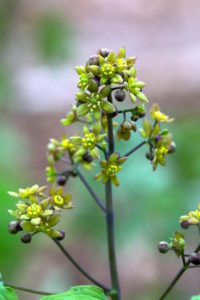
We begin at the Short Trail entrance.
Hosted by Dan Jaffe Wilder
The Short Trail is a woodland walk designed to offer a short trip for anyone with limited mobility or limited time available to them. It begins from the visitor center with a walk through a hickory grove with an understory dominated by Pennsylvania sedge (Carex pensylvanica) with patches of yellow star grass (Hypoxis hirsuta) spotted throughout.
Norcross Wildlife Sanctuary (NWS) is heavily browsed by deer and this garden is behind a deer fence, upon entering the garden proper you are greeted with a robust rich woodland scene. The canopy is a mixture of oak, black cherry and hickory and the shrub layer is dominated by pinkshell azalea (Rhododendron vaseyi), American holly (Ilex opaca), and various Viburnum species.

Rhododendron vaseyi
Texture plays a large role in the garden often filling the spaces between woodland forbs; various ferns including maidenhair (Adiantum pedatum), Braun’s holly (Polystichum braunii) and bulblet fern (Cystopteris bulbifera) hold the ground between flowering specimens such as green trillium (Trillium viride), blue cohosh (Caulophyllum thalictroides) and small yellow lady’s slippers (Cypripedium parviflorum).
- Braun’s holly (Polystichum braunii)
- Blue cohosh (Caulophyllum thalictoides)
- Small yellow lady’s slippers (Cypripedium parviflorum).
- Bulblet fern (Cystopteris bulbifera)
- Green trillium (Trillium viride)
- Maidenhair fern (Adiantum pedatum) and wild gernarium (Geranium maculatum)
Groundcovers creep in between everything leaving little open space among the taller plants. Running foamflower (Tiarella cordifolia var. cordifolia) is most common but wild ginger (Asarum canadense), creeping and woodland phlox (Phlox stolonifera and P. divaricata), green and gold (Chrysogonum virginianum) and others abound.
- Yellow trillium (Trillium luteum) and creeping phlox (Phlox stolonifera)
- Green and gold (Chrysogonum) and phlox ( Phlox divaricata)
- Asarum Canadense and Pachsyandra
Where the groundcovers don’t colonize wild geranium (Asarum canadense), wild columbine (Aquilegia canadensis), Jacob’s ladder (Polemoneum reptans), and golden alexanders (Zizia aurea) seed in; the seed bank is quite strong as every time we dig a hole to plant or move and plant one of these two species is sure to pop up.
- Tiarella and Asarum
- Wild columbine (Aquilegia canadensis) wild geranium (Gernanium maculatum)
Small patches of Jack in the pulpit (Arisaema triphyllum) are surrounded by the diminutive bishop’s cap (Mitella diphylla) requiring even the veteran plantsmen (and women) to pay close attention lest they miss something. The trail meanders around the edge of the garden with multiple smaller trails allowing access to the center eventually leading you on to other parts of NWS or simply looping back to the Visitor Center.
- Carex pensylvanica
- Jack-in-the-pultit (Arisaema-triphyllum )
- Bishops cap (Mitella diphylla)

Restful bench amongst Carex pensylvanica
About the Host
Photographer and author Dan Jaffe Wilder earned a degree in botany from the University of Maine, Orono, an advanced certificate in Native Plant Horticulture and Design from Native Plant Trust (formally New England Wild Flower Society), and has years of nursery management and plant sales experience. He is passionate about ecological horticulture, building both sustainability and wildlife value into every landscape, and the foraging and cultivation of wild edible plants. He is the Horticulturalist and Propagator for Norcross Wildlife Sanctuary and the staff photographer. His book Native Plants for New England Gardens was released spring of 2018.
***
Each author appearing herein retains original copyright. Right to reproduce or disseminate all material herein, including to Columbia University Library’s CAUSEWAY Project, is otherwise reserved by ELA. Please contact ELA for permission to reprint.
Mention of products is not intended to constitute endorsement. Opinions expressed in this newsletter article do not necessarily represent those of ELA’s directors, staff, or members.















